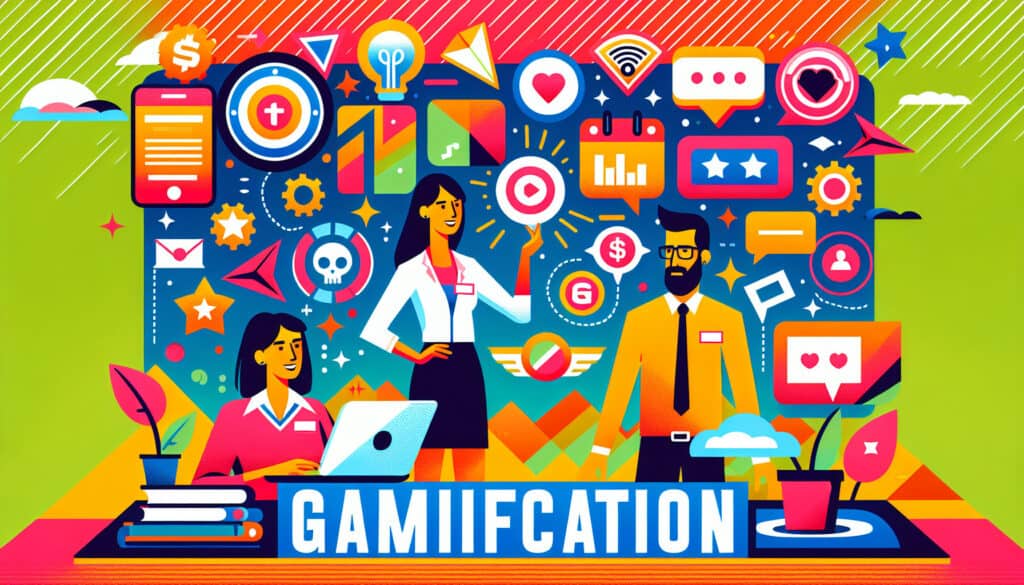Applicare elementi e principi di game-design in contesti diversi dal gioco.
- Metodologie: Ergonomia
Gamification

Gamification
- Progettazione comportamentale, Esperienza del cliente, Pensiero progettuale, Sistema di gestione dell'apprendimento (LMS), Esperienza utente (UX), Interfaccia utente (UI)
Obiettivo:
Come si usa:
- L'uso di meccaniche di gioco come punti, badge, classifiche e sfide in prodotti e servizi per aumentare il coinvolgimento e la motivazione degli utenti.
Professionisti
- Può aumentare il coinvolgimento e la motivazione dell'utente; può rendere i compiti più piacevoli.
Contro
- Può essere percepito come manipolativo se non è fatto bene; può non essere efficace per tutti gli utenti o contesti.
Categorie:
- Clienti e marketing, Progettazione del prodotto
Ideale per:
- Aumentare il coinvolgimento degli utenti in un'app di fitness o in una piattaforma di apprendimento.
La gamification trova ampie applicazioni in diversi settori, tra cui la sanità, l'istruzione e la formazione aziendale, dove il coinvolgimento dei clienti è essenziale. Nel settore sanitario, ad esempio, la gamification può essere integrata nei sistemi di gestione dei pazienti, incoraggiando le persone a rispettare i loro programmi di medicazione attraverso punti o premi per la conformità, con conseguenti migliori risultati in termini di salute. In ambito educativo, piattaforme come Duolingo utilizzano funzionalità simili a quelle dei giochi, come le strisce e i livelli, per motivare gli studenti e migliorare la conservazione, rendendo l'esperienza di apprendimento piacevole ed efficace. Le organizzazioni possono utilizzare la gamification anche nei programmi di formazione della forza lavoro, implementando simulazioni o classifiche che non solo promuovono l'acquisizione di competenze, ma favoriscono anche una sana competizione tra i dipendenti, aumentando la produttività. Questa metodologia funziona meglio quando è promossa dagli stakeholder della progettazione e dello sviluppo del prodotto, come i designer UX, i product manager e i team di marketing, che possono collaborare per creare esperienze coinvolgenti che risuonino con gli utenti. Il feedback degli stakeholder e i test degli utenti svolgono un ruolo importante nel perfezionare gli elementi di gioco, assicurando che siano in linea con le preferenze degli utenti e che promuovano i comportamenti desiderati. L'integrazione di meccaniche di gioco può anche modificare la percezione degli utenti, facendo percepire compiti banali come più gratificanti e meno faticosi, aumentando così i tassi di conformità e di soddisfazione all'interno delle applicazioni.
Fasi chiave di questa metodologia
- Definire gli obiettivi per il coinvolgimento e la motivazione nell'app di fitness o nella piattaforma di apprendimento.
- Identificare i comportamenti degli utenti target e i risultati desiderati che si allineano agli obiettivi.
- Selezionare le meccaniche di gioco più adatte alla base di utenti e al contesto dell'applicazione.
- Progettare e implementare sistemi di punti, badge e classifiche specifici per le azioni mirate.
- Creare sfide e missioni che siano rilevanti e incoraggino la partecipazione degli utenti.
- Incorporare cicli di feedback per informare gli utenti dei loro progressi e risultati.
- Testare e iterare continuamente le meccaniche di gioco in base all'interazione e al feedback degli utenti.
- Monitorare le metriche di coinvolgimento per valutare l'efficacia degli elementi di gamification.
Suggerimenti per i professionisti
- Incorporare elementi narrativi creando una trama che coinvolga gli utenti, aumentando l'investimento emotivo e il coinvolgimento durante il raggiungimento degli obiettivi o delle sfide.
- Utilizzate livelli di difficoltà adattivi nelle sfide, assicurando che gli utenti siano costantemente sfidati senza raggiungere un punto di frustrazione, il che può aiutare a mantenere l'interesse a lungo termine.
- Implementare funzioni di condivisione sociale che consentano agli utenti di celebrare i risultati raggiunti con i propri compagni, promuovendo la comunità e la competizione e aumentando al contempo la motivazione e la responsabilità.
Leggere e confrontare diverse metodologie, raccomandiamo il
> Ampio archivio di metodologie <
insieme ad altre 400 metodologie.
I vostri commenti su questa metodologia o ulteriori informazioni sono benvenuti su sezione commenti qui sotto ↓ , così come tutte le idee o i link relativi all'ingegneria.
Contesto storico
1960
1980
1983
1990
1995
2000
2010
1950
1980
1980
1986
1994
1995
2000
(se la data non è nota o non è rilevante, ad esempio "meccanica dei fluidi", viene fornita una stima approssimativa della sua notevole comparsa)














Post correlati
Questionari sul disagio muscoloscheletrico
Test multivariati (MVT)
Analisi di regressione multipla
Sistemi di cattura del movimento
Metodo MoSCoW
Test mediano dell'umore